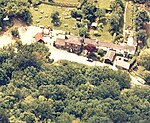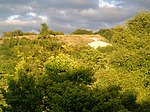Great and Little Kimble cum Marsh

Great and Little Kimble cum Marsh is a civil parish in central Buckinghamshire, England. It is located 5 miles (8 km) to the south of Aylesbury. The civil parish altogether holds the ancient ecclesiastical villages of Great Kimble, Little Kimble, Kimblewick and Marsh, and an area within Great Kimble called Smokey Row. The two separate parishes with the same name were amalgamated in 1885, but kept their separate churches, St Nicholas for Great Kimble on one part of the hillside and All Saints for Little Kimble on other side at the foot of the hill. They fall within the Hundred of Stone, which was originally one of the Three Hundreds of Aylesbury, later amalgamated into the Aylesbury Hundred. The parishes lie between Monks Risborough and Ellesborough and, like other parishes on the north side of the Chilterns, their topography are that of long and narrow strip parishes, including a section of the scarp and extending into the vale below. In length the combined parish extends for about 4+1⁄4 miles (6.8 km) from near the Bishopstone Road beyond Marsh to the far end of Pulpit Wood near the road from Great Missenden to Chequers but it is only a mile wide at the widest point. The village of Great Kimble lies about 5.5 miles (8.9 kilometres) south of Aylesbury and about 2.5 miles (4.0 kilometres) north east from Princes Risborough on the A4010 road. The parishes of Kimble have first and foremost been a farming community for nearly two thousand years and are something of a historical interest dating back chronologically to Celtic Ages. At the summit of Pulpit Hill in Great Kimble there is a prehistoric Hillfort. When Britain was taken over by Roman occupation a Roman villa was erected in Little Kimble and near St Nicholas's church is a tumulus or a burial mound commonly known as 'Dial Hill' from the same period. After the Norman Conquest of England the parishes were most likely considered too small for a stone fort, so they would have probably kept a motte and bailey castle that later developed into a moated site for a medieval dwellinghouse. It was here that John Hampden refused to pay his ship-money in 1635, one of the incidents which led to the English Civil War. The majority of the land surrounding the village and some local amenities such as the pub and the petrol station were once owned by the Russel family until they were lost many years ago to excessive gambling.
Excerpt from the Wikipedia article Great and Little Kimble cum Marsh (License: CC BY-SA 3.0, Authors, Images).Great and Little Kimble cum Marsh
Little Kimble Hill,
Geographical coordinates (GPS) Address Nearby Places Show on map
Geographical coordinates (GPS)
| Latitude | Longitude |
|---|---|
| N 51.7464 ° | E -0.8051 ° |
Address
Little Kimble Hill
Little Kimble Hill
HP17 0XR , Great and Little Kimble cum Marsh
England, United Kingdom
Open on Google Maps











